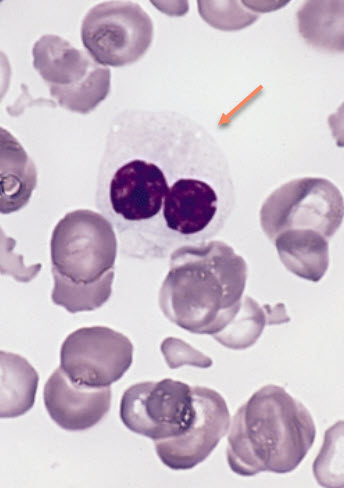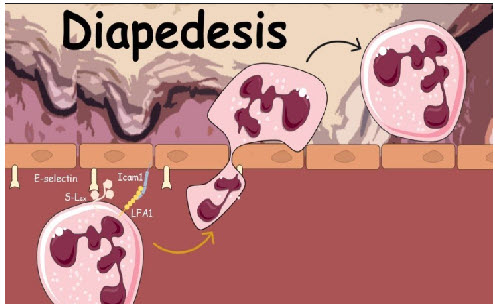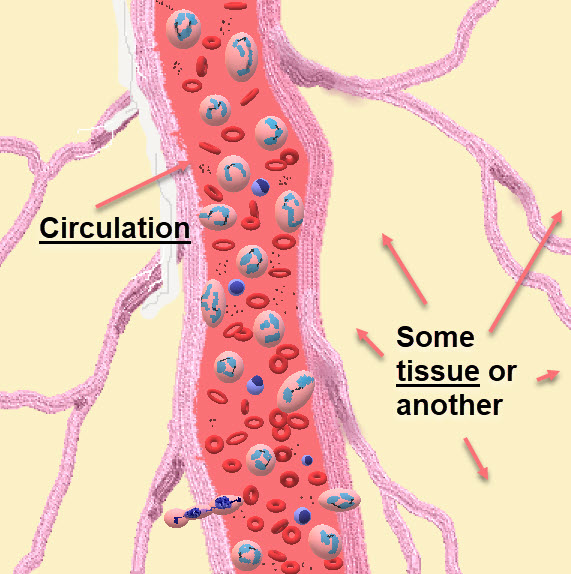Morphology in Neutrophils - brief intro
StudyLTCOVID.com
Thanks for visiting!
To translate this page, select your
language from the dropdown menu below:
Morphology in neutrophils.
The word morphology refers of course to shape. It’s the study of form.
When applied to neutrophils, (about 50 to 70% of white blood cells) one can make observations about the shape of the central chromatin material, which seems to first attract the eye.
It can have many shapes. Hence the other name by which neutrophils are referred to: polymorphonuclear leukocytes (PMNs).
One can also make observations on the shape of a neutrophil’s cell membrane, which encloses not only the cell’s chromatin (DNA) but its several other components and granules. That's morphology too.
One may find neutrophils that appear on a peripheral blood smear as mostly round or spheroidal.
Others might be a bit more egg shaped, so ovoidal.
And again, others are perhaps larger at either end than in the middle, and stretched out a bit like an ellipse,
so, ellipsoidal.
Of course these cells all come from an individual subject. (Human or otherwise, but a subject with blood). And that subject has a clinical history which goes along with the individual. That "tale" can be related to standards for “perfect” or “normal” health. At times the history captures the findings in a disease process. And at other times, the possible effects of an intervention. Exercise might be one example. One can begin to imagine different such states: awake or asleep. Fasting or post-prandial. One easily imagines other comparisons of various bodily states of a subject, effects of medicines, etc. Elements defining a protocol for study if so desired.
COVID-19 ?
Specifically in COVID-19 positive subjects, several patterns of chromatin distribution or shapes have been described.
Terms have of course appeared to describe such findings, and their variation from what is considered normal. These can get lumped first under headings.
For example: anisocytosis: abnormalities of cell size. poikilocytosis: abnormalities or variations in cell shape. These are most often used to refer to changes in red blood cells. Nothing prevents one from applying these terms to a neutrophil.
Variations in PMN chromatin shape, and specifically in the setting of COVID-19, include descriptive terms like: “fetal or C-shaped chromatin,” “ring-shaped,” “elongated chromatin” as examples. Another complicated-sounding example: “Pseudo Pelger-Huët anomaly.” (And as seen below with its 'sunglasses' chromatin). Without explaining these or others in more detail, they are of course of use when observing a patient’s neutrophils microscopically. Other COVID-19 findings for other blood cells (lymphocytes, monocytes) could be presented, but let's stick to neutrophils.
Consistent with an expression like: “If it has feathers like a duck, walks like a duck, and quacks like a duck: it’s probably a duck,” The microscopic findings, applied systematically, can lead to moments that conclude with: ”... it’s probably COVID-19.” Imagine the potential utility when other tests have been negative, or a subject does not display the most often found set of historical and physical findings for COVID-19 and sequelae.
Almost a “Eureka!” moment in the lab.
And an equally important possible conclusion: "Nothing about what is seen on this peripheral smear, suggests COVID."
Let's close in a little
One can add to such information, another aspect of morphology: the shape of a neutrophil’s cell membrane. While not discussing that part of the cell in the detail that it certainly deserves, (and it still reserves many mysteries of structure, but especially function) here is one critical component: cellular energy supply and demand and related issues.
The use and maintenance of a cell’s membrane, is what demands the most energy of the cell. One can readily find examples of how a cell tries to adjust its membrane, to changes in available energy.
When one is driving one’s car on a trip, and the dashboard light is reminding that the vehicle is running on reserve sources of energy, and one is working through the distance to the next pump, one generally lifts one’s foot a bit and slows down. Neutrophils seem to do the same thing (haven’t observed one at the wheel of a vehicle so far). It would be logical if a neutrophil could still do its work with a smaller membrane circumference, when “on reserve.” (see an article on size results on this site, here) Related: one can easily find neutrophils budding off and ejecting pieces of its membrane, when the energy supply is low-ish.
Similarly, return of a “full tank” for neutrophils and their precursors in the marrow, might be associated to subsequent appearance of larger cells (anisocytotic (size) types of thoughts).
Do the shapes vary?
Can one observe pokilocytotic findings in the cell membranes of neutrophils: i.e., variations in the observed shape? Yes. That too has been reported previously.
If one wanted to try and push a beach ball through a keyhole (Good Luck!) it might be easier if you deflate the damn thing. Changing its shape would be an important contributor to the goal. (I have no suggestions about what to do with the damn thing, once on the other side).
Same for neutrophils.
Their movement from “inside” the capillary to “outside” in the tissues includes a moment of squishiness and self-propelled push/ pull movement. That is called diapedesis. The cell membrane is more flexible: the clumped together chromatin probably less so. A neutrophil probably wants (shared with me in close personal discussions) to get its DNA through that tight space without breaking it to bits.
While neutrophils can manage this tight passage exodus just fine usually (when all the steps of the process are in order in the neutrophil AND in and between the capillary membrane cells), they are typically found rolling around in blood vessels in a spherical shape.
One might consider them in this state (and I’m imposing now on the visual observation), in readiness but not active. Or perhaps, less active. Yet, still available for a biochemical or biomolecular call to action. So, not completely on vacation.
The morphology that I call “ovoid,” is a transition state on the way to an “ellipsoid” shape. That latter is the required change for squeezing through.
These cell membrane morphology states represent a response to a “call” or change in biochemical environment. This might be locally (in endocrinology, referred to more recently as ‘paracrine’, like coming upon a wound or abscess in their travels). Or, in response to something dumped into their milieu - the circulating blood - by some unseen source, somewhere else. (Much more the original endocrine model). And it has become almost ‘de riguer’ in the populace to be able to recognize such “calls” to action (or inaction) in terms like: Interlekin-6 (pick another number if you like), Tumor Necrosis Factor, Platelet Activating Factor, and myriad others of course.
Can one match a neutrophil’s cell membrane morphology (shape), to whether it’s mostly resting, or busily changing its look to respond to action and get out there into the foray ?
Can the blend of shapes observed, lead to any conclusions of the energy state/ activity leve for the "team" (the n = ?) of neutrophils observed.
Well to forge ahead, this is exactly what I cautiously did.
I take neutrophils with a mostly spheroidal shape as inactive (or actually, less active, but ready for one of myriad possible calls).
I take neutrophils displaying an ovoidal shape as waking up, returning from vacation if you like, and accepting that “call to action” to get back to work.
And those with an “elliptical” morphology, as too busy with the response to even stop and talk a bit. They have lights and sirens going and they’re on their way to the blaze. Please step out of the way.
If one accepts any of that, and is willing to devote additional time to thinking about these tiny entities (13 or 14 microns in diameter in a light microscope. RBC’s average 7 microns), what might this imply ?
First: existence of an “in there” (capillary) and “out there” (tissues) set of environments. And since brain tissues and bone tissues (to pick two randomly) have some similarities but mostly differences, finding “parking” for oneself as one gets to the blaze may require a great deal of adaptability to various “scenes.” How one dresses when at home (capillary) might be quite different than one’s “look” when at a Birthday Party or a Funeral (tissues).
Secondly, if this notion of level of activity imposed on cell membrane morphology findings has any merit, how does it present or how does it vary in different “clinical settings” (to sound more like a physician than a fire fighter)?
Let’s next look at several such “clinical settings,” and see what we find.
Neutrophils will be categorized as “spheroidal,” “ovoidal,” and “ellipsoidal.” The ovoids and ellipses will be lumped together for counting. Those are taken as more active than the spheres, which will also be counted. Counts will also include percentages.
In categorizing observed neutrophils in this fashion, one should avoid judgements that a finding is "good" or "bad." If a blood smear (that's a sample from the circulation, so capillary side of things, not a tissue sample) shows very few neutrophils with an "active" morphology, maybe all of the "active" guys and gals are out in the tissues doing their job. To sample that, we'd need a biopsy.
Will these neutrophil cell membrane morphology findings prove to be the same in all settings, or variable ?
Final words of caution: finding what appear to be patterns or different mixes of morphology does not necessarily explain why that is so.
Finding changes in these observations on repeat sampling at different times, should include the fact that a neutrophils “life” once out of its formative infancy in the bone marrow, is quite short. Perhaps 18 to 36 hours. Some suggest some neutrophils live longer: 3 to 5 days. But those are outliers. Certain hypotheses have to fit the known facts, unless totally revolutionary and requiring throwing out, everything previously "known."
Which gets us to what or where ?
Last Final Word:
This is all about making observations, and learning from them.
For those living with "long-term" COVID-19 (LTC), such observations might be of interest.
But ultimately, if these findings can be linked to feeling better, they'd be happy I think.
I'd be happy, I'm sure.
As Louis Pasteur included in a speech one day: "Chance favors the prepared mind."
So let's continue the preparations, so Chance can move right in and finish the work.
In Surgery we used to say: "Better lucky than good," when it all worked out OK.
OK. With that introduction completed, back to the observations.



